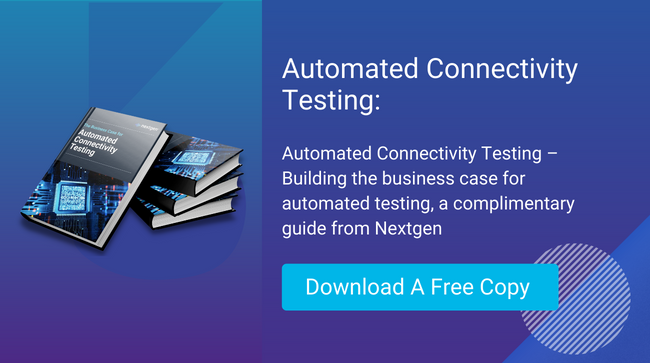Wi-Fi 7: What developers & QA engineers need to know about Wi-Fi-7

Wi-Fi 7, also known as IEEE 802.11be Extremely High Throughput (EHT), is the new Wi-Fi standard that is set to revolutionise the way we connect to the internet.
Unlike Wi-Fi 6, which was designed to handle the growing number of devices in the world, Wi-Fi 7's goal is to deliver astounding speeds for every device with greater efficiency. With support for 320 MHz ultra-wide bandwidth, 4096-QAM, Multi-RU, and Multi-Link Operation, Wi-Fi 7 promises speeds up to 4.8x faster than Wi-Fi 6 and 13x faster than Wi-Fi 5, with a potential theoretical peak of 30 Gbps.
For consumers tired of constant buffering, lag, or congestion, a Wi-Fi 7 router may soon be the solution. With support for the 6 GHz band and double the bandwidth of previous generations, Wi-Fi 7 is unlocking new possibilities and scenarios that were never before possible. The first Wi-Fi 7 routers launched in early 2023.
What is Wi-Fi 7 ? - The Key Features Explained
Wi-Fi 7 promises faster speeds and greater capacity, allowing more devices to connect to the network at once. It will enable faster data transfer rates, with a potential peak of 30 Gbps. Wi-Fi 7 will also feature improved signal quality, with better penetration through walls and other obstacles. It will be more energy efficient, reducing power consumption for devices connected to Wi-Fi 7 networks.
Wi-Fi 7 supports more advanced features such as beamforming, which focuses the signal to specific devices, and Multi-User MIMO, which allows multiple devices to communicate with the router at the same time. This enables new use cases such as high-definition video streaming and virtual reality gaming, with the ability to support multiple 4K or 8K video streams.
Wi-Fi 7 will also support new IoT devices and automation, with the ability to connect more devices to the network and provide faster communication. It will also be more secure with support for WPA3 encryption. Wi-Fi 7 devices and routers have started to become available in early 2023 and will be backwards compatible with previous versions of Wi-Fi.
One of the key benefits of Wi-Fi 7 is its ability to handle more streams and devices with greater capacity. With support for 16 x 16 MU-MIMO, Wi-Fi 7 increases the number of spatial streams from 8 to 16, effectively doubling the theoretical physical transmission rate compared to Wi-Fi 6. This means that every device connected to a Wi-Fi 7 network has enough bandwidth to run smoothly, even with a large number of devices connected at once.
In addition to increased capacity, Wi-Fi 7 also packs more data for higher speeds with its adoption of 4096-QAM. Quadrature Amplitude Modulation (QAM) is a technique to receive and transmit encoded data in radio waves. 4096-QAM (or 4k-QAM) is a higher-order modulation scheme that allows each symbol to carry 12 bits rather than 10 bits. This results in 20% higher theoretical transmission rates than Wi-Fi 6's 1024-QAM, making it possible to stream 4K/8K videos, play massive online games without lag, or live stream from your home computer without interruption.
Wi-Fi 7 also makes full use of every resource available with Multi-RU, a feature that allows multiple Resource Units (RUs) to be assigned to a single user and can combine RUs for increased transmission efficiency. This solves the problem of limited flexibility of the spectrum resource scheduling with Wi-Fi 6. To further enhance spectral efficiency, Wi-Fi 7 also uses Preamble Puncturing to block interference and open up more channels to use, eliminating waste and congestion.
A very important feature of Wi-Fi 7 is Multi-Link Operation (MLO), which enables devices to simultaneously send and receive data across different frequency bands and channels to increase throughput, reduce latency, and improve reliability for emerging applications like VR/AR, online gaming, remote offices, and cloud computing. With MLO, Wi-Fi 7 is able to deliver even better performance and reliability, making it the ideal choice for homes, offices, and other environments that require high-speed and reliable wireless connectivity.
Wi-Fi 7 - Product Development and QA teams
With the potential peak of 30 Gbps, Wi-Fi 7 will enable faster data transfer rates and support more advanced features such as beamforming and Multi-User MIMO. This new technology will also be more energy efficient, reducing power consumption for devices connected to Wi-Fi 7 networks, and will support new use cases such as high-definition video streaming and virtual reality gaming.
When it comes to Wi-Fi 7 enabled connected products, there are several key areas that need to be tested to ensure proper functionality and compliance with specifications. These include compatibility testing with existing Wi-Fi networks and devices, testing of data transfer rates and signal quality, testing of advanced features such as beamforming and Multi-User MIMO, and testing of energy efficiency.
In addition to these key areas, it is also important to test the security features of Wi-Fi 7 enabled products. With the inclusion of WPA3 encryption, testing is needed to ensure that user data is protected and that the encryption is functioning properly. This is particularly important for IoT devices and smart home systems, which rely on secure communication to function properly.
Another important aspect of Wi-Fi 7 testing is device connectivity and communication. As more and more devices become Wi-Fi 7 enabled, it is essential to test how these devices interact with one another and with other IoT devices. This includes testing of automation and control functionality for IoT devices and smart home systems.
Finally, testing in different environments and scenarios is important to ensure that Wi-Fi 7 enabled products function properly in various conditions and situations. This includes long-term testing to ensure stability and reliability over time.
Next Steps
Overall, Wi-Fi 7 is a significant advancement in wireless technology, and proper testing is critical to ensure that Wi-Fi 7 enabled products meet the highest standards of performance and security. As these advanced Wi-Fi 7 devices launch to market, it is important to ensure that connected products are properly tested to deliver the best possible experience for users. For more information about our Wi-Fi testing services and how Nextgen can support your project, please contact us today on +44 3331 120 000.




